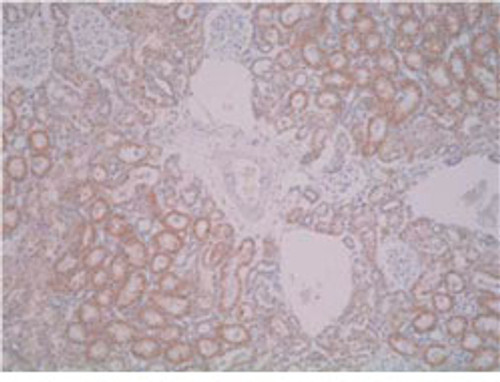Anti Glyoxylate And Hydroxypyruvate Reductase (GRHPR) C-terminal region mAb (Clone 1H1)
Cosmo Bio
- SKU:
- KAL-KC597
- Shipping:
- Calculated at Checkout
$803.00
//Function Enzyme with hydroxy-pyruvate reductase, glyoxylate reductase and D-glycerate dehydrogenase enzymatic activities. Reduces hydroxypyruvate to D-glycerate, glyoxylate to glycolate oxidizes D-glycerate to hydroxypyruvate.
//Catalytic activity Glycolate + NADP+ = glyoxylate + NADPH. D-glycerate + NAD(P)+ = hydroxypyruvate + NAD(P)H.
//Subunit structure Homodimer.
//Tissue specificity Ubiquitous. Most abundantly expressed in the liver.
//Involvement in disease Defects in GRHPR are the cause of hyperoxaluria primary type 2 (HP2) [MIM:260000]; also known as primary hyperoxaluria type II (PH2). HP2 is a disorder where the main clinical manifestation is calcium oxalate nephrolithiasis though chronic as well as terminal renal insufficiency has been described. It is characterized by an elevated urinary excretion of oxalate and Lglycerate.
Reference
1. "Identification and expression of a cDNA for human hydroxypyruvate/glyoxylatereductase." Rumsby G. et al. Biochim. Biophys. Acta 1446:383-388(1999) [PubMed: 10524214] [Abstract]. Cited for: NUCLEOTIDE SEQUENCE [MRNA], SUBUNIT. Tissue: Liver.
2. "The gene encoding hydroxypyruvatereductase (GRHPR) is mutated in patients with primary hyperoxaluria type II." Cramer S.D. et al. Hum. Mol. Genet. 8:2063-2069(1999) [PubMed: 10484776] [Abstract]. Cited for: NUCLEOTIDE SEQUENCE [GENOMIC DNA / MRNA], INVOLVEMENT IN HP2. Tissue: Liver.
3. Liu B. et al. Submitted (DEC-1998) to the EMBL/GenBank/DDBJ databases. Cited for: NUCLEOTIDE SEQUENCE [LARGE SCALE MRNA]. Tissue: Aorta
| Product Specifications | |
| Application | ELISA, IHC, WB |
| Reactivity | Rat, Human |
| Clonality | Monoclonal (Clone No.: 1H1) |
| Host | Mouse |
| Documents & Links for Anti Glyoxylate And Hydroxypyruvate Reductase (GRHPR) C-terminal region mAb (Clone 1H1) | |
| Datasheet | Anti Glyoxylate And Hydroxypyruvate Reductase (GRHPR) C-terminal region mAb (Clone 1H1) Datasheet |
| Documents & Links for Anti Glyoxylate And Hydroxypyruvate Reductase (GRHPR) C-terminal region mAb (Clone 1H1) | |
| Datasheet | Anti Glyoxylate And Hydroxypyruvate Reductase (GRHPR) C-terminal region mAb (Clone 1H1) Datasheet |


